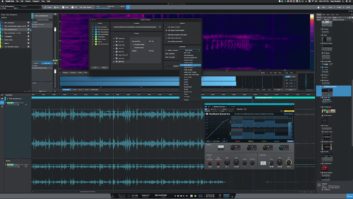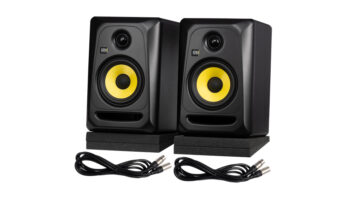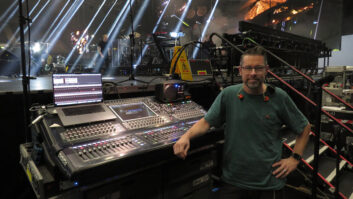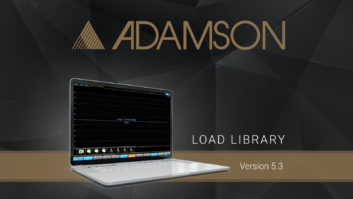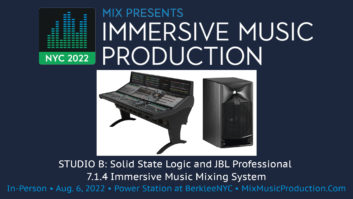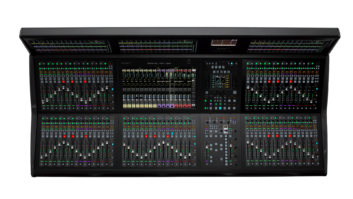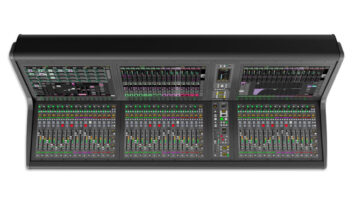The Euphonix MC Media Application Controller and System 5-MC represent the company’s vision of the future of audio/video production. The goal is to provide efficient, seamless and simultaneous control of multiple DAWs and video apps, with full high-res metering, EQ and pan graphical curve displays, along with the interactivity of automation and real-time plug-ins.
Communication between computer/apps and the MC/System 5-MC is via a high-speed Ethernet network and the Euphonix EuCon protocol. So far, this high-speed control protocol is integrated into Nuendo, Pyramix and Digital Audio Denmark’s product line. For non-EuCon applications, the HUI/Mackie Control protocol (over Ethernet) and keyboard macros for the MC’s 56 LCD SmartSwitches are used.
THE MIGHTY MC
The MC has a familiar look as it’s also the center section of a System 5-MC mixing console. Perfect for project studios and post film/TV editorial use, the MC stands alone with its internal power supply, computer and hard drive. Software updates can be accomplished using a USB Flash drive or Internet download. Apart from a talkback audio output jack, power and a USB port, the only other external connection is the Ethernet connector. A flat-panel LCD screen monitors connected apps and computers. When you change applications, a DVI switcher adjusts the display to the appropriate software/computer.
The MC’s layout is modular: Each section has a Setup button that immediately shows that section’s status and configuration on a compact 1,024×768 touchscreen for directly programming the control surface. The screen shows each networked workstation’s setup; file management; system setup, preferences, track selection and management; flip or the swapping of System 5-MC faders and knobs; and soft-key setup for function assign and keyboard assign to SmartSwitches. The touchscreen also allows naming, storing, recalling and deleting Edit Control banks, soft-key banks, user sets and application sets. You can also set up preset layouts to control and assign tracks.
The MC offers four levels for controlling all apps and computers: a QWERTY keyboard, SmartSwitches for programmable keystrokes, HUI and Mackie Control command protocol over Ethernet and high-speed network control of EuCon-aware apps.The keyboard is flanked by two edit control modules, each with identical four-button Kensington jog wheel and trackball assemblies. Dual trackballs can be used, or either ball can be swapped out for a jog wheel insert, accommodating left- and right-handed operators.
SMARTSWITCHES
MC’s open architecture allows you to program or map any DAW commands assigned to keystrokes in their respective application programs to any of the SmartSwitches. You can assign any keystroke command to any SmartSwitch, including transport controls.
Each SmartSwitch button has a backlit LCD window with the name and/or designated icon describing its function. You can control the window’s color, font size and style, or develop your own icon library in any bit-mapping application. Each control module is augmented by 16 SmartSwitches — 10 directly above the jog wheel or trackball inserts and six more to either side. I found that this simple-to-learn, intuitive arrangement was also easy on my carpal tunnels.
Six more banks of 24 SmartSwitches above the keyboard are used for all other key commands. Each bank can also have a sub-bank for nearly limitless functionality. You can map any of these switches and store them in Application sets. Also, any switch can be “locked” so that it always performs the same function no matter which application is onscreen. This locking feature is ideal for a EuCon-controlled DAW’s transport controls.
The MC comes with a large number of pre-built Application sets. (Download more at www.euphonix.com.) You can modify these and re-save them as your own personal set that travels with you; they can be stored externally to a USB Flash drive. Next to the SmartSwitch banks are eight soft-knob shaft encoders, each having lighted buttons and eight SmartSwitches. These knobs control EuCon-enabled applications — mainly to adjust plug-ins, aux sends, mix groups, routing and inserts — and can also be mapped for the HUI and Mackie Control.
EUCON PROTOCOL
The EuCon protocol is a fast, high-resolution, powerful technology that can boost the speed and creative quality of your workflow. (See Mix, April 2003.) When connected to a EuCon-enabled app, control becomes total and complete. There is continual, high-speed, bi-directional communication from the surface to the application with no latency or feeling of detachment. Using this system for mixing was my best experience yet with a DAW controller. The controller’s instant, glitch-free response allowed me the freedom of a totally musical approach with my mixing fader gestures, without thinking about or compensating for the system.
The high-speed connection allows for real-time, high-resolution, multiformat metering and for both pan and EQ graphical displays on the System 5-MC’s 1,024×768 TFT channel screens. Furthermore, the edit/jog/shuttle wheel can be used for real-time trim head/tail, fade head/tail, position, zooming, clip gain, slip and more. Full live adjustment (with no latency) of your favorite plug-ins inserted into channel strips is also a reality.
The MC stand-alone has a section fitted with four assignable faders that are identical to those on the System 5-MC. These faders control track levels in both EuCon and HUI applications. Just as in the System 5-MC, there are Solo, Mute, Select, Record keys and read/write automation switches. LED meters indicate input level to that fader. Nudge and Bank buttons move these four faders down the tracks in your session. All track faders include the Euphonix Wave key, which, when pushed, causes that track to become “in focus”: in the center of the LCD screen with all applicable editing SmartSwitches and touchscreen ready for your input.
STUDIO MONITOR PRO
Comprehensive monitor routing and control are handled by Studio Monitor Pro software, which resides in the DAW’s application or in a secondary, dedicated monitoring workstation, and controls audio routing between apps that support ASIO or Core Audio hardware and the actual hardware I/O boxes. Its interface module is located on the MC’s surface; use the touchscreen to set control room sources and listen to external audio inputs without starting up any DAW apps. There is provision for a talkback mic and multiple speaker outputs, comprising main, alt 1 in 5.1 and alt 2 in stereo, each with level, mute and dim. An upcoming Version 2 will offer 7.1 monitoring.
SYSTEM 5-MC
A System 5-MC mixing console would comprise at least one MC and any number of “bucket of eight” CM408T channel strip modules. Each CM408T has its own internal processing unit, is individually powered and communicates over a single Ethernet cable. On the System 5-MC, the section with four assignable faders on the MC is replaced with a module, with two fully automatable, motorized joystick panners.
A popular configuration, with two CM408Ts on either side of the MC, offers a total of 32 channel strips. Other custom frame options include angled sections, speaker shelves, script trays and producers’ tables with built-in monitors. There is space for a flat-panel DVI monitor of up to 30 inches. I like that the screen and VESA mount are recessed down well below the sight line of the center-channel monitor speaker.
[Note: A new, hybrid option for the standard range of System 5 consoles will be introduced at NAB 2006, letting an operator mix faders controlling multiple DAWs on the surface next to Euphonix DSP faders. — Eds.]
EXPANDED LOCAL CONTROL
Switches change the function of the CM408T’s eight touch-sensitive knobs between controlling an EQ, dynamics plug-in (or any other plug), pan, aux sends and bus routing. Each of these functions, when selected, changes the knob’s backlit color. A knob’s function is also indicated by a four-character display next to it. The channel strip’s individual TFT display graphically shows EQ curve, dynamics and panning used, as well as parameter names and values. The channel strip’s Swap button changes, either individually or globally, to a second layer with eight more audio sources — effectively doubling the CM408T’s input channels.
Any track can be brought up on any of the 100mm faders and saved as a Layout. Surround sources up to 7.1 are controlled from a single strip, always with the channel’s TFT display showing that channel’s output on up to eight meters. A four-character LED dual-designation display shows the track name, while the TFT repeats the channel’s status and name (up to 14 characters long). When mixing, I especially liked setting the stereo LED input meter to always indicate audio to that channel even if it’s muted. I also liked that the Wave key is available for every track fader so you can quickly “see” that track’s status on the LCD screen at any time.
BRIDGING THE GAP
The MC and System 5-MC present a completely different approach to audio/video control, made possible by Euphonix’s development of the extensible EuCon protocol. EuCon bridges the application/workstation gap by allowing the MC and System 5-MC to connect their control surfaces to multiple disparate applications running on different workstation computers. The System 5-MC combines a traditional console mixing worksurface with the MC’s intelligent key-command layout of any application’s recording, editing and mixing functions. Able to support any current and future workstations, both systems are ergonomically designed to enhance creativity and improve work quality and speed.
Prices: MC, $19,995; System 5-MC, priced depending on configuration.
Euphonix Inc., 650/855-0400, www.euphonix.com.
Barry Rudolph is an L.A.-based engineer.
